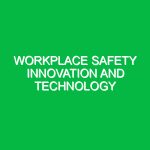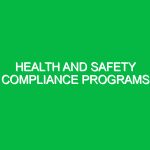In an ever-evolving world where high-risk tasks are commonplace in various industries, the establishment of robust safety procedures is not just a regulatory requirement but a moral imperative. Safety procedures for high-risk tasks encompass a set of guidelines and practices designed to minimize the risks associated with potentially dangerous activities. Whether you are working in construction, manufacturing, or healthcare, understanding these safety procedures is crucial for protecting yourself and your colleagues. This article delves into the importance of these procedures, outlines potential hazards, discusses precautionary measures, and highlights relevant regulations and standards.
The Importance of Safety Procedures in High-Risk Tasks
The relevance of safety procedures in high-risk tasks cannot be overstated. They serve as a framework that guides employees in identifying hazards, assessing risks, and implementing effective control measures. A well-structured safety procedure not only reduces the likelihood of accidents but also fosters a culture of safety within the organization. In my experience, when I worked on a construction site, the implementation of rigorous safety protocols transformed the work environment. Prior to these measures, incidents were frequent, but after we adopted a comprehensive safety plan, the rate of accidents dropped significantly. This shift highlighted the direct correlation between safety procedures and the well-being of workers.
Identifying Potential Hazards and Risks
Understanding the potential hazards associated with high-risk tasks is the first step in developing effective safety procedures. These hazards can be broadly categorized into several types:
1. Physical Hazards
Physical hazards include anything that can cause harm due to environmental conditions. Examples include:
- Slips, Trips, and Falls: Uneven surfaces, spills, or obstacles can lead to falls, which are among the most common workplace injuries.
- Machinery and Equipment: Improper use or lack of maintenance can result in accidents involving heavy machinery.
- Noise: Prolonged exposure to loud sounds can cause hearing loss and other health issues.
2. Chemical Hazards
Exposure to harmful chemicals can occur in various industries, particularly in manufacturing and healthcare. Examples include:
- Toxic Substances: Chemicals such as solvents, pesticides, or heavy metals can pose severe health risks.
- Flammable Materials: Improper storage and handling can lead to fires or explosions.
- Respiratory Hazards: Inhalation of dust, vapors, or gases can cause long-term respiratory illnesses.
3. Biological Hazards
In healthcare and laboratory settings, workers may encounter biological hazards, such as:
- Pathogens: Bacteria, viruses, and other microorganisms can cause infections.
- Allergens: Exposure to mold or other allergens can lead to respiratory issues.
4. Ergonomic Hazards
These hazards relate to the design of work tasks and equipment. Examples include:
- Repetitive Motions: Tasks that involve repetitive movements can lead to musculoskeletal disorders.
- Poor Posture: Working in awkward positions can cause strain and injury over time.
Best Practices and Safety Precautions
Once potential hazards are identified, implementing best practices and safety precautions becomes essential for minimizing risks associated with high-risk tasks. Here are some actionable measures:
1. Conduct Regular Risk Assessments
Regular risk assessments help identify new hazards and evaluate existing risks. This proactive approach ensures that safety procedures remain relevant and effective. A risk assessment should include:
- Identifying hazards in the workplace.
- Assessing the likelihood and severity of potential incidents.
- Implementing control measures to mitigate risks.
2. Provide Comprehensive Training
Training is a cornerstone of effective safety procedures. Employees should receive thorough training on:
- Proper use of personal protective equipment (PPE).
- Emergency response protocols.
- Safe operating procedures for machinery and equipment.
When I was part of a team responsible for heavy machinery operation, we underwent extensive training. This included both theoretical lessons and hands-on practice. The difference it made in our confidence and ability to operate safely was striking.
3. Utilize Personal Protective Equipment (PPE)
Personal protective equipment is essential for safeguarding workers against identified hazards. The type of PPE required depends on the specific task and associated risks. Common types of PPE include:
- Hard Hats: Protect against head injuries from falling objects.
- Safety Goggles: Shield eyes from chemical splashes or flying debris.
- Ear Protection: Guard against noise-induced hearing loss.
- Respirators: Protect against inhalation of harmful substances.
4. Develop and Implement Emergency Response Plans
Every workplace engaged in high-risk tasks should have a well-defined emergency response plan. This plan should outline procedures for:
- Evacuating personnel in the event of an emergency.
- Communicating effectively during an incident.
- Providing first aid and medical assistance.
During my time in a manufacturing facility, we conducted regular drills to practice our emergency response. These exercises not only prepared us for potential incidents but also fostered a sense of teamwork and readiness.
5. Promote a Safety Culture
A strong safety culture encourages employees to prioritize safety in their daily tasks. This can be achieved by:
- Encouraging open communication about safety concerns.
- Recognizing and rewarding safe practices.
- Involving employees in the development of safety procedures.
Regulations and Standards Governing Safety Procedures
Several regulations and standards govern safety procedures for high-risk tasks. Familiarity with these can enhance compliance and promote safer working environments. Here are some key regulations:
1. Occupational Safety and Health Administration (OSHA)
In the United States, OSHA sets and enforces standards for workplace safety. Their regulations cover numerous industries and provide guidelines for hazard communication, PPE usage, and emergency preparedness.
2. National Institute for Occupational Safety and Health (NIOSH)
NIOSH conducts research and makes recommendations for preventing work-related injuries and illnesses. Their guidelines inform safety procedures and educational programs to enhance workplace safety.
3. International Organization for Standardization (ISO)
ISO 45001 is a standard that provides a framework for occupational health and safety management systems. It emphasizes proactive measures for preventing work-related injuries and promoting worker well-being.
Conclusion
Safety procedures for high-risk tasks are indispensable in safeguarding the health and well-being of employees. By identifying potential hazards, implementing best practices, and adhering to regulations, organizations can create safer workplaces. Moreover, fostering a culture of safety not only protects workers but also enhances productivity and morale. As we continue to navigate the complexities of various industries, let us prioritize safety procedures and commit to a safer future for all.


